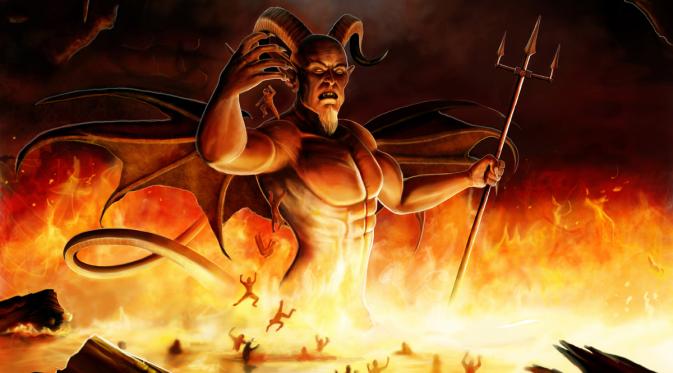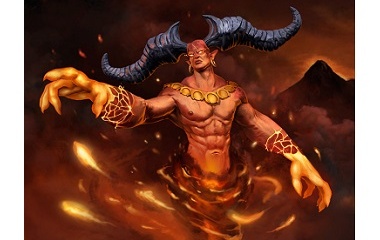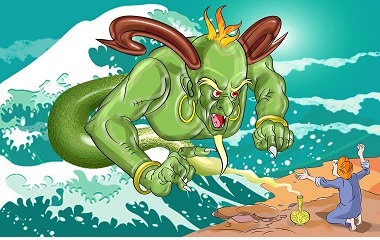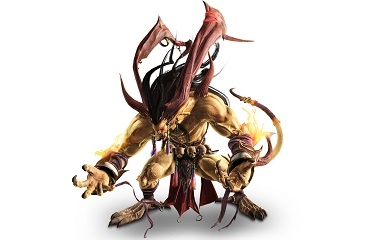It is said that if you dare to look inside the tombs of the Pharaohs without knowledge of an anti-spell to serve as protection, you will be cursed with the wrath of the Pharaohs. Should you befall this misfortune and smell a great stench it is likely too late – the wrath of the Ifrits will soon be upon you.
What is an Ifrit?
An Ifrit is a creature that comes to us from Arabic lore. This creature is supposedly connected to their creation story and, is therefore, one of the more feared and respected figures in their lore.
Ifrits are supposedly a type of jinn that have a rebellious nature. In fact, the word ‘ifrit’ seems to be a reference to the spirit of this jinn subcategory. Arabic philologists agree that the root ‘-f-r’ tends to be used to indicate objects or beings who are ‘rebellious’ and ‘strong.’
The Ifrits are Cast Out of Favor
According to mythology, the Ifrit was one of the first groups of beings to be created by Allah and were proud of their form. However, the introduction of humans posed a problem for the Ifrit and other jinn. They could not see how this new race, made of brittle clay, could rival their superior form which was made of smokeless fire. One Ifrit in particular named Iblis refused to accept Allah’s favor towards Adam.
For Iblis’ disobedience, he was cast out of Allah’s favor. Though he should have been killed for his sins, he was granted respite until Judgement day. However, he still bears a large grudge towards humans because of his lost favor. Because of this grudge, he is said to strive to lead all humans astray in hopes that they too will loose favor with Allah. For his deceptions and evil intents, Iblis is often referred to as Shaitan.
Many who study religion believe that Iblis is the Islam equivalent of Satan. He is the jinn who is said to have tempted Adam and Eve, causing them to be cast out of paradise. However, though Iblis (like Satan) is thought to have caused the fall of man, there are noticeable differences in the interpretations of each religious text. The most noticeable is that Iblis is not seen as a rival of Allah. He will not fight Allah when judgment day comes, but will die with all the other souls who have defied their creator. He is also not seen as an angel because he was given free will and the Islam faith dictates that angels always obey their creator.
Are all Ifrit Malevolent
Though an Ifrit is always considered to be an evil or malevolent being, there is the possibility that these beings can have pure souls. Ifrits are similar to humans in that they are given free will and are therefore able to make their own decisions about how they live their lives. They can be believers or nonbelievers and could be pure of heart or evil in nature. Ifrit who believe in Allah are thought to sometimes appear in the houses of Muslims in the form of a snake. Because of this, it is forbidden to kill them before the name of Allah has been mentioned at least three times as a warning to these jinn. If the snake remains in the home of the believer after Allah’s name has been mentioned three times, it can be safely assumed that the snake is a devil and the beast can be killed without question.
Ifrit Societies
Ifrit are also interesting in that they are known to live with social structures similar to that of humans. They have kings, queens, and royal families as well as a social hierarchy that is said to resemble that of desert tribesmen. They are also said to have marriages that abide by similar rules as human marriages. They are known to marry their own kind, though they do have the ability to marry humans and have children with their human spouses.
As jinn, ifrit are known to be much more powerful than humans and even spirits, though their power is not as mighty as an angel’s. The ifrit is often known to be cunning with its magic – likely because Iblis is not the only one of the ifrit to hold a grudge towards Allah’s favoring of man over jinn.
Forms of the Ifrit
Although the ifrit enjoy appearing in their mighty form, they are capable of appearing in other forms as well. When an ifrit appears in its natural form, it is a strong smoke-like being made of fire. However, when they appear in a different form, they are able to disguise itself as either animals or ordinary humans. There are some legends that suggest an ifrit in human form may appear as people who had been turned black by fire. It is because of this that many Africans were thought to be (or referred to as) Ifrit by those who were raised with Arabic lore.
Ifrit are known for their immense power. As their name suggests that they are either incredibly strong or rebellious (or both), they are often feared. In addition to their strength, they have the same powers as other jinn. This includes being able to transform into nearly any shape they desired and the ability to cast spells. They were also immune to mortal weapons, which meant that their great power and might was often unable to be matched by human power alone.
Can an Ifrit be Overpowered or Killed?
It is thought that the only way to truly hold power over an ifrit is to use magic. Although the ifrit are very strong and durable, they are not magical beings. Therefore the use of magic presents a unique opportunity for humans. With it, they are able to harm and kill ifrits, as well as bind them into servitude. The use of magic by humans is the only thing that ifrits and other jinn truly fear when dealing with humans. Magic was often used to bind ifrits to objects. Whoever possessed the object that bound an ifrit was considered to be the ifrit’s master. It is from these magic practices that the three wishes legend originated from.
Though magic was the most common way known to harm or capture and ifrit, there were other ways to gain power over these creatures. One of the most common ways for an ordinary citizen to protect themselves from ifrit was to simply recite a du’a. A du’a is considered to be a profound act of worship. As such, it makes sense that this would be thought to protect a person from the ifrit because it was demonstrated in Iblis’ defiance of man that Allah would come to the aid of man if necessary.
Alternative Explanations for the Creation of Ifrits
Although the above description of ifrit is the most widely accepted, there are old legends that suggest ifrit may have a different source of origin. Some of these legends suggest that in ifrit is not made from smokeless fire, but from the blood of a murder victim. These versions often say that once an ifrit had formed from the blood of a murder victim, they were free to take the shape of the deceased victim, a sandstorm, or Satan himself. It is from this origin that these legends explain the vengeful nature of ifrits.
There are also legends that work to combine the implications of both stories. Many legends that take from the idea of ifrits being a subsection of jinn and ifrits being created from the blood of murder victims claim that these creatures are not made of the blood of victims, but rather drawn to it. These ifrit are supposedly able to gain power from the spirit (or blood) of murder victims and are often driven to do the will of those who were murdered. Because of this, these legends often tell of how an ifrit was driven to seek revenge against the murder of the victim whose soul they drew power from.
Famous Ifrit
Iblis

Iblis is perhaps the most famous of the ifrit people and is known for his disobedience to Allah. The ifrit Iblis was angered at Allah’s favoritism towards Adam and Eve because they were of a new race that he considered to be inferior to his people. As an ifrit, Iblis was made of smokeless fire and was given more power and strength than humans. He looked upon Allah’s new creations of brittle clay with disdain.
When he refused to kneel before Adam, he was cast out of Allah’s favor and barred from paradise. It is thought that all ifrits have a deep disdain for humans because of this event. However, even though Iblis was cast out of Allah’s favor, his life has been spared until Judgement Day. It is said that Iblis is using his extra time to tempt man into damnation as revenge.
Hamou Ukaiou
Hamou Ukaiou is an evil ifrit who is said to be married to another jinn named Aicha Kandida. The couple is known for their similar night hunting tactics. Hamou preys on women while Aicha preys on men.
Hamou Ukaiou is known for targeting women who travel alone at night in the hopes that he will find an opportunity to attack and devour them. He is a fearful entity and is part of the reason that female travelers are reluctant to venture on their own at night.
Although most ifrit are not affected by human weapons, it is thought that sharpening a knife on the ground may be cause for Hamou Ukaiou to flee from his intended target.
The Three Wishes Myth
Although ifrit are considered to be powerful and mighty creatures, there are thought to be several ways to gain power over the creatures. The most common are to use magic or invoke Allah through prayer.
Because a person can use magic over an ifrit to harm them or bind them to an object, the legend of the three wishes evolved over time. It was thought that if a person were to come across an item that had an ifrit bound to it, that person would be granted three wishes if they were to rub or clean the object.
It is important to note, however, that even an enslaved ifrit is still incredibly sly and cunning. If an ifrit were enslaved or bound to an object against their will, they would often use the wording of their master’s wish against them. Instead of granting wishes that honored the intentions of their masters, they would grant wishes that followed the exact wording of the desire implored to them. In this way, they were still able to undermine their master’s power and exact revenge against those who tried to harness their power without consent.
There are also variations of the three wishes myth that imply that ifrit would sometimes trick people into making more than three wishes. Once a fourth wish had been made, the previous three wishes would become undone. This would help ifrit take revenge against anyone who managed to word their wishes precisely enough that their desires could not be used against them.
Although the three wishes myth became very popular, it appears to be no more than a myth. The majority of stories regarding ifrit bound to items implies that they will only follow the wishes of the master who currently posses their object. They will only do the bidding of another if ownership of the item has been transferred to that person.
Physical Appearance
An ifrit is said to be an enormous creature with wings. These beings are a subcategory of jinn and are said to be made of smokeless fire. These beings are often depicted as having fierce features that are sometimes terrifying to humans. Many ancient depictions of ifrit suggest that these creatures sometimes have horns or fangs.
There are also many descriptions that say that ifrit are often capable of appearing in any shape or form they desire. They can appear in the shape of an animal (and are noted to commonly appear as dogs) or a person with no threatening characteristics. It is said that ifrit who choose to take human form normally appear to be burned by fire. Because of this, people from the Middle East are sometimes known to refer to those of African descent as ‘ifrit.’
Although ancient legends tell us tat ifrit are made from smokeless fire and humans are said to be made of clay, it is possible for an ifrit and a human to produce children together. Despite this possibility, many ifrit choose to marry within their own race of peoples.
Ifrit and Free Will
Although the majority of ifrit are thought to be evil and malevolent, there is the possibility for ifrit to be of pure heart or to do good deeds. Because they are jinn, they are capable of making their own decisions about how to conduct their lives. They live in social structures that are similar to those of humans. In fact, ifrit are known to have kings, tribes, and clans that function with similar social structures as the human equivalents to these groups. These ifrit are free to have their own beliefs and as such can choose to follow any religion that they wish.
Despite the fact that ifrit are known to be capable of good deeds, they are often seen as evil creatures. This is largely because of their resentment towards Allah’s favor towards his creation of man over the creation of jinn. Ifrit are known to be especially bitter towards this favoritism and are known to take their revenge by causing humans to fall out of favor with Allah.
Ifrit are known to be very mischievous and are thought to scam humans for entertainment. Those who believe in jinn often point to ifrits as culprits of scams committed in modern day.
Ifrit in Modern Day
Sightings During the Early 1900’s
Although ifrit are largely considered to be purely mythical, there were frequent sightings of these creatures in Egypt up until the Second World War. There are no indications as to the reason for the sightings, though a possible conclusion is that the exposure to the scientific based explanations of the Western World helped to identify more reasonable explanations for strange occurrences.
Regardless of why the sightings stopped, it seemed to be common knowledge in the early 1900’s that ifrit who lived in the desert and were fond of leading humans into misfortune. It was said to be a common occurrence for ifrit to appear in the shape of a dog and lead travelers into the desert until they became lost. Many British soldiers who visited the pyramids were warned of such occurrences by locals.
The Tomb of DrAb el Naga
In the northern parts of Qurna (which is most commonly called DrAb el Naga), a family was using a cave as a stable and lumber room. One day, while working to remove rubbish from his stable, the owner came across an opening to a passageway. It was then that he realized his stable was not in an ordinary cave – rather it was part of a undecorated tomb that had likely belonged to one of Egypt’s ancient royals. The owner was immediately excited by the possibilities of treasure and wealth for his family and continued to excavate the site in secret. He did tell his family about the discovery, but kept the information to a very limited few.
The man continued to excavate the site and reached the point where he would be able to open the passageway that led to the tomb. Instead of exploring the site right away, however, he waited for a day that his family was away.
The next morning, his wife was curious about her husband’s disappearance and ventured into the stables. She found the passageway and entered. Several hours later, the mother of the wife followed into the passageway in search of her daughter. When the grandmother didn’t return, a cousin went into the passageway in search of her body. When that cousin didn’t return, a second cousin went in after him.
After the second cousin failed to return, two relatives who were growing nervous with concern decided to go down together with candles. They found the second cousin laying on the floor and drug him back out to the stable entrance. Unfortunately, they didn’t find him fast enough and he died soon after.
The police were called and arrived with an antiquities inspector who was hoping to find the treasure that was mentioned by the family. The policemen and inspector went down together and explored the pathway until the air began to smell foul. They thought they found the bodies of the earlier victims, but were unable to reach them because of their extreme nausea.
Although everyone present agreed that an ifrit was responsible for the deaths of the family members, the official cause of death was listed as asphyxia by poisonous gas. The site is now protected – no one is allowed to open or enter the site again.
Other Jinn
Marid
Of all the jinn, the marid are the most similar to the ifrit. It is thought that these may actually be the same species of jinn because of the close meaning of the two names (marid is also another word for ‘rebellious’). There are varying opinions when it comes to the relation of these two creatures, though it seems the majority of people recognize these two jinn as different races.
Though ifrit are very powerful, the marid are said to be the strongest of all the jinn. They are difficult to control, but are very knowledgeable – especially with magic – and have been known to lend assistance to kings and holy men throughout history.
The marid are blue in color and are thought to be spirits of the sea. It is said that their blue coloring signifies their great intelligence and superior age.
Explanation of the Myth
Ifrit are found in the creation story that is recorded in the Quran. Though there is no definite proof of their existence, their appearance in religious texts is likely a result of the belief in Allah’s abilities to create many races and creatures.











the marid sound like the blue human type people in india’s mythology lol. Very cool page of mythology!!
I loved the elaborate details in the mythology of this species.
Thanks for the info